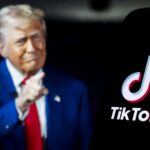
It looks like Microsoft may just be buying popular Chinese social media app, TikTok afterall. The Seattle based company confirmed media reports that it has held talks with ByteDance the parent company of TikTok to buy its operations in the United States and intends to close this deal by September 15.
About three days ago when reports of this started hitting the airwaves, the US President Donald Trump has said he was opposed to any deal that would see Microsoft buy out the US operations of TikTok, thereby favouring an outright ban of the service in the United States. But it looks like the discussion is going beyond just acquiring TikTok US operations but Canada and Australia according to a Microsoft statement. Microsoft CEO Satya Nadella also spoke to President Trump as well.
In a statement, Microsoft said “This new structure would build on the experience TikTok users currently love, while adding world-class security, privacy, and digital safety protections. The operating model for the service would be built to ensure transparency to users as well as appropriate security oversight by governments in these countries.”
The US president according to US news has agreed to give ByteDance 45 days to cut a deal with Microsoft on the takeover. As part of the deal, Microsoft is said to have agreed to move all TikTok US data in-country and any data stored elsewhere would be deleted. The issue of data storage location and sharing has been a major bone of contention that has US authorities advise Americans to stop using the service especially government staff. TikTok has been accused of sharing data with the Chinese government according to Chinese national security law that forces tech companies including the banned Huawei to share data with the government upon request. But TikTok has always maintained that its US data is stored in the United States and not elsewhere as alleged. That may be true but Western advocates have always been sceptical that as long TikTok remains a Chinese company, it doesn’t matter where it says it stores data and that it could be easily accessed by the Chinese government.
But Microsoft is not new to the social media space. Microsoft invested $240m in Facebook back in 2007 and has worked closely with them on a number of partnerships with the most recent one being Microsoft shutting down its game streaming service Mixer and integrating rather with Facebook Gaming. It also encourages users to switch to the Facebook service. It also acquired professional social media service LinkedIn for $26b in 2016. That said, buying TikTok may be a bit more complicated than its previous acquisitions and investments because of the age group of people who use it. TikTok users are predominantly 18-35 years of age just like Snapchat but Instagram which is Facebook company has over time developed features that look closely like what you see on TikTok and Snapchat. But the Facebook service that closely resembles TikTok is called Lasso but is now being shut down. Facebook didn’t say if it would eventually redevelop such a service in future to take on TikTok. YouTube is reportedly working on Shorts to take on TikTok but the Microsoft acquisition may complicate matters for YouTube as an American company with influence and the financial muscle as YouTube’s parent company, Google.
TikTok’s office is located in a place that used WhatsApp’s office before it was acquired by Facebook and has reportedly since hired quite a number of Facebook employees so you can see why it may be complicated for a Facebook investor such as Microsoft to be buying a competitor such as TikTok. Maybe Microsoft may bring TikTok to the Facebook table eventually, who know- it’s just a wild idea I don’t see happening though.
TikTok’s parent company ByteDance has been on the acquisition spree itself since it opened up the app to the rest of the world back in 2017. They bought Musical.ly for about $800m, a company Facebook had tried to acquire. But it looks like that’s going to be a Microsoft company soon.
Discover more from TechBooky
Subscribe to get the latest posts sent to your email.







